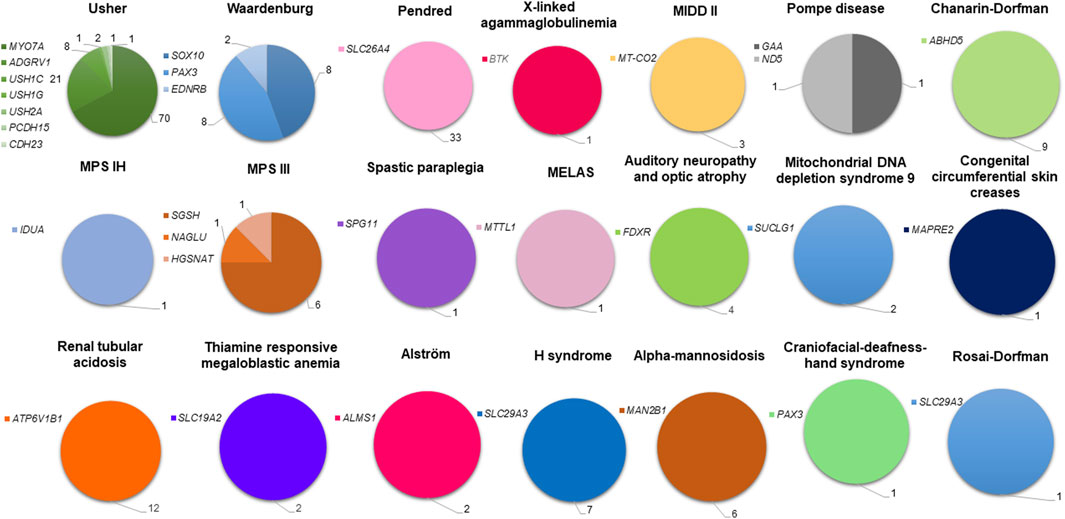
94% of researchers rate our articles as excellent or good
Learn more about the work of our research integrity team to safeguard the quality of each article we publish.
Find out more
CORRECTION article
Front. Genet. , 25 June 2024
Sec. Genetics of Common and Rare Diseases
Volume 15 - 2024 | https://doi.org/10.3389/fgene.2024.1437233
This article is a correction to:
Current phenotypic and genetic spectrum of syndromic deafness in Tunisia: paving the way for precision auditory health
 Rahma Mkaouar1*
Rahma Mkaouar1* Zied Riahi1
Zied Riahi1 Jihene Marrakchi1,2
Jihene Marrakchi1,2 Nessrine Mezzi1,3
Nessrine Mezzi1,3 Lilia Romdhane1,4
Lilia Romdhane1,4 Maroua Boujemaa1
Maroua Boujemaa1 Hamza Dallali1
Hamza Dallali1 Marwa Sayeb1
Marwa Sayeb1 Saida Lahbib1
Saida Lahbib1 Hajer Jaouadi1,5
Hajer Jaouadi1,5 Hela Boudabbous6,7,8
Hela Boudabbous6,7,8 Lotfi Zekri1,9
Lotfi Zekri1,9 Mariem Chargui1
Mariem Chargui1 Olfa Messaoud1
Olfa Messaoud1 Meriem Elyounsi10,11
Meriem Elyounsi10,11 Ichraf Kraoua12,13
Ichraf Kraoua12,13 Anissa Zaouak14
Anissa Zaouak14 Ilhem Turki12,13
Ilhem Turki12,13 Mourad Mokni15
Mourad Mokni15 Sophie Boucher16,17
Sophie Boucher16,17 Christine Petit18,19
Christine Petit18,19 Fabrice Giraudet20,21,22
Fabrice Giraudet20,21,22 Chiraz Mbarek23
Chiraz Mbarek23 Ghazi Besbes24
Ghazi Besbes24 Soumeyya Halayem1,25
Soumeyya Halayem1,25 Rim Zainine1,24
Rim Zainine1,24 Hamida Turki26
Hamida Turki26 Amel Tounsi27
Amel Tounsi27 CRYSTEL Bonnet18
CRYSTEL Bonnet18 Ridha Mrad10,11
Ridha Mrad10,11 Sonia Abdelhak1
Sonia Abdelhak1 Mediha Trabelsi10,11
Mediha Trabelsi10,11 Cherine Charfeddine1,28
Cherine Charfeddine1,28A Corrigendum on
Current phenotypic and genetic spectrum of syndromic deafness in Tunisia: paving the way for precision auditory health
by Mkaouar R, Riahi Z, Marrakchi J, Mezzi N, Romdhane L, Boujemaa M, Dallali H, Sayeb M, Lahbib S, Jaouadi H, Boudabbous H, Zekri L, Chargui M, Messaoud O, Elyounsi M, Kraoua I, Zaouak A, Turki I, Mokni M, Boucher S, Petit C, Giraudet F, Mbarek C, Besbes G, Halayem S, Zainine R, Turki H, Tounsi A, Bonnet C, Mrad R, Abdelhak S, Trabelsi M and Charfeddine C (2024). Front. Genet. 15:1384094. doi: 10.3389/fgene.2024.1384094
In the published article, there was an error in the legend for Figure 4 as published. The gene names corresponding to color degradation for the Waardenburg syndrome pie chart are incorrect.

Figure 4. Genetic spectrum of syndromic deafness in the Tunisian population. Deafness syndromes with known molecular etiologies are represented by pie charts. Each syndromic deafness is indicated with a different color. Color degradation has been adopted to specify the gene(s) associated with each syndrome. The number of patients carrying variants in each gene is provided.
The corrected legend appears below: The SOX10 gene should be at the top (darkest blue), and the EDNRB gene should be at the bottom (lightest blue). Consequently, the number of patients should be 8 for the SOX10 gene and 2 for the EDNRB gene.
In addition, there was an error in the caption of Figure 4 in the published version of the manuscript: “FIGURE 4: Genetic and mutational spectrum of syndromic deafness in the Tunisian population. Deafness syndromes with known molecular etiologies are represented by pie charts. Each syndromic deafness is indicated with a different color. Color degradation has been adopted to specify the gene(s) associated with each syndrome. The number of variants identified in each gene is provided.”
The corrected Figure 4 appears below:
The authors apologize for these errors and state that this does not change the scientific conclusions of the article in any way. The original article has been updated.
All claims expressed in this article are solely those of the authors and do not necessarily represent those of their affiliated organizations, or those of the publisher, the editors and the reviewers. Any product that may be evaluated in this article, or claim that may be made by its manufacturer, is not guaranteed or endorsed by the publisher.
Keywords: syndromic deafness (SD), spectrum of SDs, next-generation sequencing (NGS), early detection, under-diagnosis, Tunisia
Citation: Mkaouar R, Riahi Z, Marrakchi J, Mezzi N, Romdhane L, Boujemaa M, Dallali H, Sayeb M, Lahbib S, Jaouadi H, Boudabbous H, Zekri L, Chargui M, Messaoud O, Elyounsi M, Kraoua I, Zaouak A, Turki I, Mokni M, Boucher S, Petit C, Giraudet F, Mbarek C, Besbes G, Halayem S, Zainine R, Turki H, Tounsi A, Bonnet C, Mrad R, Abdelhak S, Trabelsi M and Charfeddine C (2024) Corrigendum: Current phenotypic and genetic spectrum of syndromic deafness in Tunisia: paving the way for precision auditory health. Front. Genet. 15:1437233. doi: 10.3389/fgene.2024.1437233
Received: 23 May 2024; Accepted: 27 May 2024;
Published: 25 June 2024.
Edited and reviewed by:
Ferran Casals, University of Barcelona, SpainCopyright © 2024 Mkaouar, Riahi, Marrakchi, Mezzi, Romdhane, Boujemaa, Dallali, Sayeb, Lahbib, Jaouadi, Boudabbous, Zekri, Chargui, Messaoud, Elyounsi, Kraoua, Zaouak, Turki, Mokni, Boucher, Petit, Giraudet, Mbarek, Besbes, Halayem, Zainine, Turki, Tounsi, Bonnet, Mrad, Abdelhak, Trabelsi and Charfeddine. This is an open-access article distributed under the terms of the Creative Commons Attribution License (CC BY). The use, distribution or reproduction in other forums is permitted, provided the original author(s) and the copyright owner(s) are credited and that the original publication in this journal is cited, in accordance with accepted academic practice. No use, distribution or reproduction is permitted which does not comply with these terms.
*Correspondence: Rahma Mkaouar, cmFobWEubWthb3VhckBmc3QudXRtLnRu
Disclaimer: All claims expressed in this article are solely those of the authors and do not necessarily represent those of their affiliated organizations, or those of the publisher, the editors and the reviewers. Any product that may be evaluated in this article or claim that may be made by its manufacturer is not guaranteed or endorsed by the publisher.
Research integrity at Frontiers

Learn more about the work of our research integrity team to safeguard the quality of each article we publish.